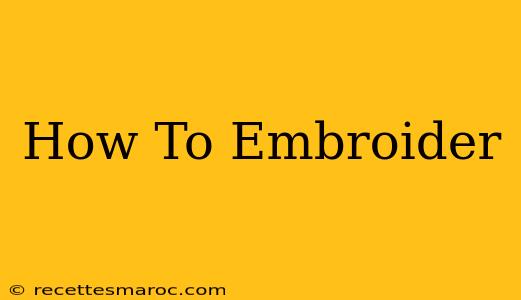Embroidery is a relaxing and rewarding craft that allows you to create beautiful, personalized designs on fabric. Whether you're a complete beginner or looking to refresh your skills, this guide will walk you through the essential steps to get started with embroidery. We'll cover everything from choosing your materials to mastering basic stitches.
Getting Started: Gathering Your Supplies
Before you begin stitching, you'll need to gather a few essential supplies. Don't worry, you don't need a huge investment to get started!
Essential Embroidery Supplies:
- Embroidery Hoop: This keeps your fabric taut and makes stitching much easier. Different sizes are available; choose one that's comfortable for your hands.
- Embroidery Fabric: Evenweave fabric is a popular choice for beginners due to its even texture. Aida cloth is another excellent option, especially for counted cross-stitch.
- Embroidery Needles: Sharp needles with a blunt tip are crucial to prevent snagging your fabric. Choose sizes appropriate for your thread.
- Embroidery Floss: This is your thread! Embroidery floss is typically six strands twisted together, allowing you to separate them for thinner lines.
- Scissors: A small, sharp pair of embroidery scissors is essential for precise cutting of your floss.
- Fabric Marker or Pencil: (Optional but helpful) Use this to lightly mark your design on the fabric. Choose a marker that washes or fades away easily.
Mastering Basic Embroidery Stitches
Once you have your supplies, it's time to learn some basic stitches. These stitches form the foundation of most embroidery projects.
1. The Running Stitch:
This is the simplest stitch, perfect for outlining or creating straight lines. Simply bring the needle up from the back, skip a small distance, and bring the needle back down. Repeat.
2. The Backstitch:
The backstitch creates a solid, even line that's ideal for outlining and filling in areas. Bring the needle up, insert it back down a short distance away, and then bring it up again directly behind the first insertion point. This creates a continuous line.
3. The Satin Stitch:
The satin stitch is used to create solid, smooth areas of color. Work closely spaced parallel stitches to fill an area completely.
4. The French Knot:
This stitch creates a small, decorative knot. Wrap the thread around the needle once (or more, for a larger knot), then insert the needle close to where it emerged, pulling the thread through to create the knot.
Choosing Your First Embroidery Project
For your first project, consider a simple design. Many free patterns are available online for beginners. Start with something small and manageable to build your confidence and skills. A simple floral motif or geometric pattern is a great starting point.
Tips for Successful Embroidery:
- Keep your fabric taut: A loose fabric will make stitching difficult and uneven.
- Use a comfortable needle size: Too large, and the stitches will be loose; too small, and it will be difficult to work with.
- Don't be afraid to experiment: Embroidery is all about personal expression!
Expanding Your Embroidery Skills
Once you've mastered these basic stitches, you can explore more advanced techniques and stitches, like the chain stitch, lazy daisy stitch, and seed stitch. Numerous online resources, books, and classes can help you expand your skills and create increasingly intricate designs.
Embroidery is a journey, not a race. Enjoy the process, be patient with yourself, and celebrate your progress along the way. Happy stitching!

